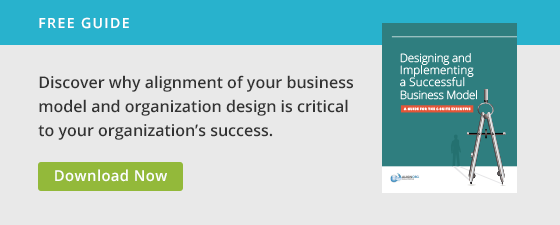There is not always a clear path to an organization design and implementation of a strategic plan. While leadership might decide that a change is in the best interest of the company, there are many obstacles that could stand in the way of a real change transformation.
Our work with hundreds of companies over the years has identified seven impediments that are typically the underlying cause of ineffective change. Asking the following questions can help to determine the root of the problem:
- Is there a good business case for the change? Or is the organization design simply something that leadership feels they need to do. If there is not a valid reason to change, people will not buy into what you want to do and why it is necessary.
- Do people understand what is really changing and what they need to do differently? What needs to be done might seem obvious to company leadership. After all, they designed the new business model, communicated it to the team and told everyone what to do to implement the change. Even so, we frequently hear: “I do not understand why nothing has really changed. We told them what to do.” It’s not that simple. Leadership must define exactly how to implement change. It is not enough to tell a sales team that they now have to sell solutions when they have always sold stand-alone products. Leadership has to define what they mean by solutions and not leave it to the sales people to figure it out.
- Is leadership committed to the change transformation? Some leaders may be, others may not. If everyone involved is not onboard and in support of the organization change, efforts to make an effective change may be lackluster or even sabotaged.
- Does the organization equip individuals to be successful? Leadership must provide the resources necessary to make the change. Staff may need to be trained, talent hired, additional funds allocated to departmental budgets, etc.
- Is the organization in alignment with the change transformation? Processes and procedures must support the change. Leadership has to follow through and align every aspect of what they are doing within the organization. If the company does not change the way the accounting structure works for example, a department’s budget might still include a line item that it is no longer accountable. To enable change transformation, something as simple as realigning people or funds to the department that will have accountability in the future is an important step.
- Are there events competing for the resources required to make the change transformation? Competing events can be internal such as the IT department being focused on the deployment of a new logistics system instead of the customer relationship management (CRM) system required to move forward with a strategic initiative to improve service. Or external events like regulatory changes or competitors introducing a new product or any number of other issues that could impact the company.
- Will external stakeholders accept the organization change? You can do all of the right things with the organization design, define a winning strategy and effectively implement the change transformation but if an external stakeholder is not in agreement you might have to go back to the drawing board. Your largest client might advise you that if you make the change they will take their business to a competitor causing you a loss in profits and market share. In this case leadership has to consider whether or not to move forward and if the change is worth risking a valued customer relationship.
Any or all of the above circumstances can stand in the way of an effective organization design and successful change transformation. Leaders must understand and adapt to the change in order for it to transpire. Otherwise you risk that nothing will happen other than rearranging the boxes on an organization chart.
An effective organization design requires a thoughtful process of change management that includes teaching leaders to be alignment leaders, communicating the value of the change, ensuring that everyone involved knows what to do and how to do it, as well as putting a plan in place to mitigate potential risks.

